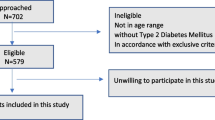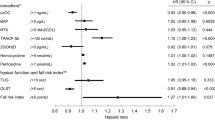Abstract
Intercurrent illness and episodes of hospitalization and surgery are common in an aging population, who, at the same time, are experiencing age-related bone loss. The objective was to test the hypotheses (1) that intercurrent illness severe enough to require hospitalization produces clinically important bone loss, and (2) that antiresorptive therapy will reduce that loss. The study was a retrospective analysis of bone mineral density (BMD) change at hip and spine in subjects of the risedronate postmenopausal osteoporosis phase III trials experiencing serious adverse events (SAEs). Subjects were 243 hospitalized for non-skin cancers, pneumonia, myocardial infarction, cerebrovascular accident, gallbladder disease, and pancreatitis, on whom BMD data were available both before and after the SAE; and 286 non-hospitalized control subjects matched to those with SAEs by age, height, weight, prevalent fracture, and visit interval. In hospitalized, placebo-treated participants, the annualized percent change in BMD (mean ± SEM) across the period of hospitalization was −0.65±0.39 at lumbar spine, −1.13±0.55 at femoral neck, and −2.66±0.58 at femoral trochanter; the corresponding values for the non-hospitalized, placebo controls were +0.46±0.28, −0.77±0.34, and −0.67±0.34. These values were more negative at all three sites for the hospitalized subjects, and significantly so at lumbar spine and femoral trochanter ( P =0.019 and 0.002, respectively). By contrast, in the risedronate-treated participants, all sites exhibited bone gain and there was no significant difference between hospitalized and non-hospitalized participants. Intercurrent illness resulting in hospitalization produced a rapid bone loss across the period of illness comparable in magnitude to documented age-related loss. Risedronate in a dose of 5 mg/day effectively abolished this loss.


Similar content being viewed by others
References
Whedon GD, Heaney RP (1991) Effects of physical inactivity, paralysis, and weightlessness. In: Hall B (ed) Bone, vol. 7. CRC Press, Boca Raton, FL, USA, pp 57–77
Donaldson CL, Hulley SB, Vogel JM, Hattner RS, Bayers JH, McMillan DE (1970) Effect of prolonged bed rest on bone mineral. Metabolism 19:1071–1084
LeBlanc AD, Schneider VS, Evans HJ, Engelbretson DA, Krebs JM (1990) Bone mineral loss and recovery after 17 weeks of bed rest. J Bone Miner Res 5:843–850
Krølner B, Toft B (1983) Vertebral bone loss: an unheeded side effect of therapeutic bed rest. Clin Sci 64:537–540
McClung MR, Geusens P, Miller PD, Zippel H, Bensen WG, Roux C, Adami S, Fogelman I, Diamond T, Eastell R, Meunier PJ, Reginster JY for the Hip Intervention Program Study Group (2001) Effect of risedronate on the risk of hip fracture in elderly women. New Engl J Med 344:333–340
Harris ST, Watts NB, Genant HK, McKeever CD, Hangartner T, Keller M, Chesnut CH 3rd, Brown J, Eriksen EF, Hoseyni MS, Axelrod DW, Miller PD for the Vertebral Efficacy with Risedronate Therapy (VERT) Study Group (1999) Effects of risedronate treatment on vertebral and non-vertebral fractures in women with postmenopausal osteoporosis. A randomized controlled trial. JAMA 282:1344–1352
Reginster J, Minne HW, Sorensen OH, Hooper M, Roux C, Brandi ML, Lund B, Ethgen D, Pack S, Roumagnac I, Eastell R for the Vertebral Efficacy with Risedronate Therapy (VERT) Study Group (2000) Randomized trial of the effects of risedronate on vertebral fractures in women with established postmenopausal osteoporosis. Osteoporos Int 11:83–91
McClung M, Bensen W, Bolognese M, Bonnick S, Ettinger M, Harris S, Knecht T, Lang R, Miller P, Pavlov E, Silverman S, Woodson G, Faulkner K, Ethgen D, Axelrod D (1998) Risedronate increases bone mineral density at the hip, spine and radius in postmenopausal women with low bone mass [Abstract]. Osteoporos Int 8 [Suppl 3]:111
Fogelman I, Ribot C, Smith R, Ethgen D, Sod E, Reginster JY (2000) Risedronate reverses bone loss in postmenopausal women with low bone mass: results from a multinational, double-blind, placebo-controlled trial. J Clin Endocrinol Metab 85:1895–1900
Soininvaara TA, Jurvelin JS, Miettinen HJA, Suomalainen OT, Alhava EM, Kroeger PJ (2002) Effect of alendronate on periprosthetic bone loss after total knee arthroplasty: a 1-year, randomized, controlled trial of 19 patients. Calcif Tissue Int 71:472–477
LeBlanc AD, Driscol TB, Shackelford LC, Evans HJ, Rianon NJ, Smith SM, Feeback DL, Lai D (2002) Alendronate as an effective countermeasure to disuse induced bone loss. J Musculoskelet Neuronal Interact 2:335–343
Van der Poest Clement E, Patka P, Vandormael K, Haarman H, Lips P (2000) The effect of alendronate on bone mass after distal forearm fracture. J Bone Miner Res 15:586–593
Ruml LA, Dubois SK, Roberts ML, Pak CYC (1995) Prevention of hypercalciuria and stone-forming propensity during prolonged bed rest by alendronate. J Bone Miner Res 10:655–662
Chappard D, Minaire P, Privat C, Berard E, Mendoza-Sarmiento J, Tournebise H, Basle MF, Audran M, Rebel A, Picot C, Gaud C (1995) Effects of tiludronate on bone loss in paraplegic patients. J Bone Miner Res 10:112–118
Chappard D, Alexandre C, Palle S, Vico L, Morukov BV, Rodionova SS, Minaire P, Riffat G (1989) Effects of a bisphosphonate (1-hydroxy ethylidene-1,1 bisphosphonic acid) on osteoclast number during prolonged bed rest in healthy humans. Metab Clin Exp 38:822–825
Minaire P, Depassio J, Berard E, Meunier PJ, Edouard C, Pilonchery G, Goedert G (1987) Effects of clodronate on immobilization bone loss. Bone 8 [Suppl 1]:S63–S68
Lockwood DR, Vogel JM, Schneider VS, Hulley SB (1975) Effect of the diphosphonate EHDP on bone mineral metabolism during prolonged bed rest. J Clin Endocrinol Metab 41:533–541
Acknowledgement
The authors wish to thank John Banner, MS, for statistical programming support
Author information
Authors and Affiliations
Corresponding author
Rights and permissions
About this article
Cite this article
Heaney, R.P., Valent, D.J. & Barton, I.P. Hospitalization-related bone loss and the protective effect of risedronate. Osteoporos Int 17, 212–216 (2006). https://doi.org/10.1007/s00198-005-1975-4
Received:
Accepted:
Published:
Issue Date:
DOI: https://doi.org/10.1007/s00198-005-1975-4




